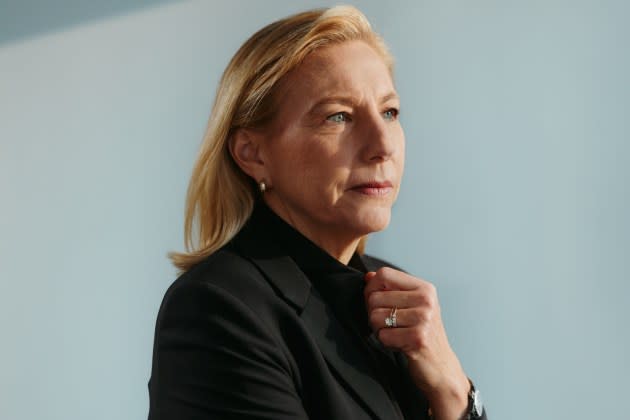Joanne Crevoiserat Touts ‘Step Change’ in Tapestry Growth

Updated 4:33 p.m. ET Feb. 6
Coach stepped back into the spotlight with Tapestry Inc.’s fiscal second-quarter results and the brand is looking good.
More from WWD
Here's Why the Coach Brooklyn Bag Became One of the Hottest Designer Bags to Buy Now
Coach, Moncler, Saint Laurent Rise, Miu Miu Remains Top Spot on Lyst Hottest Brands Ranking
EXCLUSIVE: Tapestry Advances 'Digital Twinning' Through Adobe Collaboration
Shares of Tapestry shot up 12 percent to $82.20 after the company topped earnings estimates and said Coach, its largest business, drove organic sales up 10 percent to $1.7 billion in the quarter.
Joanne Crevoiserat, chief executive officer of Tapestry, told WWD the company had seen a “step change” in growth after years spent retooling and preparing for a fast-changing and more digital world.
“While this work has been going on for a long time, it’s compounding,” Crevoiserat said. “We have never lost focus on our brand building principles and we continue to build more capabilities to deliver against those principles, stronger emotional connections with our consumers. We’re acquiring new and younger consumers at an increasing rate.
“We’re clearly taking share in many markets, including in China, and we’re growing, we’re doing that while we’re growing gross and operating margins,” she said. “It is these compounding capabilities where we’re leveraging, our insights on how to deliver more compelling and more relevant product, more compelling and relevant marketing and storytelling and better experiences around the world.”
If Tapestry’s sales growth saw a step change, so has the narrative around the company.
For the past year and a half, the story of Tapestry was dominated a series of questions around the company’s $8.5 billion deal to buy Capri Holdings — from how the firm would turn around Michael Kors once the deal closed to whether the deal would close at all.
Now that the deal is definitively off, the focus is squarely on Coach and a turnaround of the smaller Kate Spade.
Wall Street likes the simpler story. Shares of Tapestry have nearly doubled since a Manhattan federal judge effectively nixed the deal by granting a preliminary injunction requested by government antitrust lawyers.

Tapestry is now focused on building its momentum.
While net income slipped to 3.7 percent to $310.4 million, or $1.38 a diluted share, adjusted earnings per share came in at $2 — 25 cents ahead of the $1.75 analysts forecast, according to Yahoo Finance.
Revenues for the three months ended Dec. 28 rose 5 percent to $2.2 billion, ahead of the $2.11 billion analysts projected. The top-line growth at Coach was offset by Kate Spade, which saw organic sales drop 10 percent to $416.4 million. (Sales at Stuart Weitzman, which sources say the company has contemplated selling, fell 16 percent to $69.7 million.)
Tapestry is still interested in deals, but has committed to steering away from any acquisitions until Kate Spade gets back to sales growth.
“We had some missteps in our execution clearly, and we’re taking action on those,” Crevoiserat said of Kate Spade. “We have a new CEO [Eva Erdmann] at Kate who is a proven brand builder, but over time we’ve also learned and honed our capabilities. So the brand building principles that we can talk about today are principles that we’ve learned and built over time. We’re much smarter today than we were even four years ago.”
Part of the idea behind the Capri acquisition was that Tapestry could take the playbook that’s worked at Coach and use it to rev up Michael Kors. Now the company can apply that approach to Kate Spade without the distractions of a mega deal.
The Tapestry approach includes a little marketing and product magic mixed with the science of big data and artificial intelligence.
“When we started our acceleration program four years ago, we didn’t know where it was going, but we knew technology was moving fast and consumer engagement with technology was moving even faster,” Crevoiserat said. “For us to keep pace, we knew we had to put the technology in the hands of the people who are making decisions in our business.
“What we have today are tools that are at the fingertips of our product developers, of our designers, tools that are at the fingertips of our merchandising talent. Our merchants are having more robust conversations because we have these tools that have predictive demand models.
“So as they build a product, they understand where it’s likely to resonate, either around the globe or with a particular consumer segment,” she said. “And we have good dialogue about that and make adjustments. So it’s not just there’s a pricing tool out there. We have tools that are informing our entire value chain from product creation all the way through price and assortment allocations.”
For the full year, the company is now expecting earnings per share to grow by 13 percent to 14 percent to a range of $4.85 to $4.90, up significantly from the $4.50 to the $4.55 previously forecast.
Most of that increase, 17 cents worth, came from outperformance in the business, but another 10 cents from share repurchases while 8 cents came from a tax benefit.
This fiscal year, Tapestry expects to spend $2 billion in total to buy back stock and pay dividends to shareholders.
Best of WWD
Harvey Nichols Sees Sales Dip, Losses Widen in Year Marred by Closures
Nike Logs $1.3 Billion Profit, But Supply Chain Issues Persist
Sign up for WWD's Newsletter. For the latest news, follow us on Facebook, Twitter, and Instagram.

 Yahoo Lifestyle
Yahoo Lifestyle 
